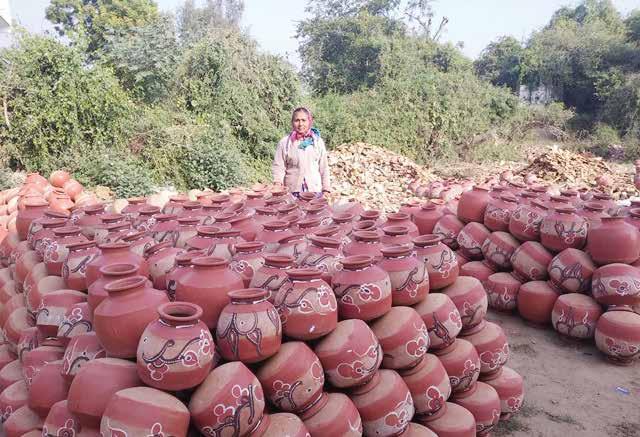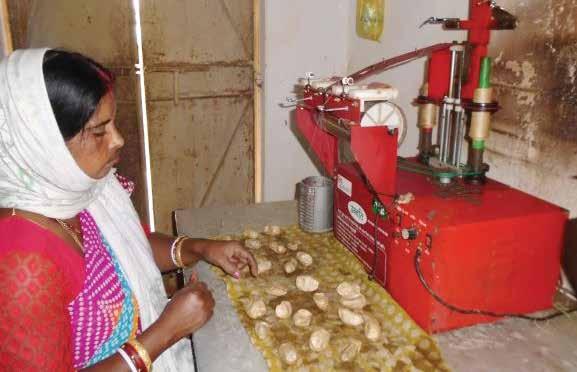
3 minute read
Study Recommendations
financing institutions. Lack of awareness and sensitizations on solar potential have also led to little or no dissemination. The present national- and state-level MSME and solar policies encourage the use of non-conventional energy sources including solar in manufacturing sector, however lack of implementing guidelines discourage financing of solar PV system in the sector except silk sector scheme of Ministry of Textile, Government of India.
» The primary survey has enabled in the design of appropriately sized solar PV system across the clusters and enterprises. While the smallest solar PV size is needed in Maganpur sewing cluster (as small as 150 Wp) of Jharkhand, the biggest solar PV size is needed in Chhannapatna wooden toy cluster (as big as 14 kWp) of Karnataka. Similarly, the aggregate solar potential has been highest in salt cluster and lowest in the pottery cluster of Gujarat. All four clusters of Karnataka and salt cluster of Gujarat have significantly higher solar PV potential.
Advertisement
» The business models developed across the clusters and enterprises reveal the payback period of solar PV investment in Jharkhand is minimum (1 to 3 years) with zero subsidy which is an exception in comparison to all clusters of Karnataka and Gujarat where subsidy to the tune of 40% to 65% is needed to keep payback period in and around 5 years period with same bank interest rate (8% per annum).
» The survey interactions and findings reveal many direct and indirect impact benefits of solar PV that may of course vary from cluster to cluster. Adoption of solar PV is expected to replace conventional fuel and related expenses and reduce subsidy burden as well as enhance working hours, employment, and income.
The feasibility study is expected to develop possible business models for the uptake of solar PV systems in the micro-enterprise sectors of India. Based on this study, the following key recommendations have been provided here: i. Introduction of solar PV scheme for micro-enterprises The Ministry of MSME (MoMSME) or Ministry of New and Renewable Energy (MNRE), Government of India may come up with a new ‘solar PV scheme for MSME sector, particularly for targeting microenterprise sectors in rural areas’. Such schemes will encourage significant solar adoption, which will reduce the cost of production and increase profitability. It will further help in replacement of polluting diesel gen-sets usage in the micro/ home-based enterprises. ii. Financial assistance under existing MSME schemes
MoMSME, Government of India schemes such as Micro and Small Enterprises Cluster Development Programme (MSE-CDP), Prime Minister Employment Guarantee Programme (PMEGP) and Revamped Schemes of Fund for Regeneration of Traditional Industries (SFURTI) as well as newly introduced ‘Atmanirbhar Bharat Abhiyan’ may facilitate credit-linked capital subsidy facilities for inclusion of solar PV systems in the microenterprises. iii. Constitution of technical committee
State-level technical advisory committee may be constituted comprising experts from finance, technology, policy, and procurement to address the impediments that have been limiting the uptake of solar PV in the sector. iv. Facilitating small loans for microenterprise clusters Small loans at affordable rate should be facilitated to micro-entrepreneurs for adoption of solar PV
systems. It would enable more attractive payback periods and reduce financial burden on microenterprises. Loans could be made available from financing scheme, such as ‘MUDRA’ by sensitizing all other financing agencies including MFI/RRBs/ SFIs/cooperative, etc. for solar procurement.
v. Converting state power subsidy to onetime capital subsidy
It is proposed that the state government may allocate the power subsidy to respective DISCOM (in states such as Karnataka) in order to promote grid-interactive solar PV rooftop programme in the micro-enterprise cluster roping in organizations such as EESL and IREDA to facilitate financing.
vi. Awareness generation and demo piloting
Creation of awareness and sensitization among the micro-enterprise clusters have been recommended on existing solar PV schemes and incentives. Further, to ensure the quality of the solar PV system, a list of approved solar integrators should be made available from time to time to these prospective entrepreneurs. The solar integrators or other agencies may be encouraged with incentives for promoting solar PV in the micro-enterprise clusters. As a way forward, demonstration model of solar PV in the identified cluster may be considered to showcase the technical and business prospects of the system to the micro-entrepreneurs, financiers, and policymakers.
vii. Multi-stakeholders collaboration
Multipronged strategies may be needed through multi-stakeholder’s collaboration including policymakers, consultants, local administration (e.g. district industry centers) suppliers, bankers, research institutions, and the civil societies for arranging resources for successful piloting and then scaling up of solar PV applications in rural micro-enterprise clusters.
6 Study the Feasibility and Potential of Solar Applications in Micro, Small and Medium Enterprises in Rural India




